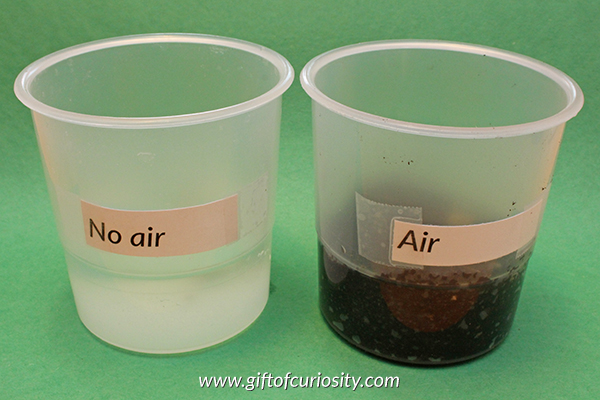This post may contain affiliate ads at no cost to you. See my disclosures for more information.
After my kids and I sprouted seeds to see what the process entailed, we decided to carry out a series of seed experiments to learn more about seeds. Our seed experiments were designed to answer questions about what kinds of conditions seeds grow best in.
In two previous posts I shared the results of our experiments that asked the questions: “Do seeds need light to grow?” and “What temperature do seeds like?“
In this third seed experiment, we addressed the question: “Do seeds need air to grow?“
Note: For more seed activities your kids will love, see my Botany Unit Study page.

For any experiment, it is important to set up conditions so that the only difference between the conditions is related to what you want to test. Because we wanted to test how seeds grow with and without access to air, it was important that all of the growing conditions for our seeds be the same EXCEPT for their access to air.
We started with two plastic cups. We filled the “no air” cup about 1/3 full of water, but no dirt. We filled the “air” cup about 1/3 full with dirt and a bit of water. To both cups we added three different seeds: a broccoli seed, a lettuce seed, and a pea seed. (The seeds were part of this set of heirloom seeds I purchased.)
We then placed both cups on our kitchen window sill for about a week to see how the seeds would grow. I added water as needed to the “air” cup to ensure it remained moist. I did not add any water to the “no air” cup.

After a week we checked our seeds to see how they had grown. In the “air” cup (on the right in the picture below), all three seeds had started sprouting. The pea seed had put out a little shoot, while the broccoli and lettuce seeds had begun forming leaves. (It is a bit difficult to see in the picture since the broccoli leaves are covering the lettuce leaves).
In the “no air” cup, all three seeds appeared to have started spouting, but then had stopped growing. They never formed nice, big leaves like the seeds in the “air” cup. In fact, the tiny leaves that began forming separated from their seed, which would have prevented them from continuing to grow.

So after conducting this experiment, how would we answer our question “Do seeds need air to grow?”
We learned that the answer was yes. The seeds in both cups softened and began to sprout. But only the seeds with access to air continued to grow and form leaves. The seeds in the “no air” cup stalled in their growth, indicating that without air they will not thrive.
More resources for learning about seeds
More posts about seeds from Gift of Curiosity:
- Books about seeds
- Exploring seeds from packets
- Exploring seeds from nature
- Sprouting seeds
- Seed medallions craft
- Experiment: Do seeds need light to grow?
- Experiment: What temperature do seeds like?
- Experiment: Do seeds need their seed coat?
- Experiment: What liquids do seeds like?
For more seed activities your kids will love, see my Botany Unit Study page and my Botany & Gardening Pinterest board.
Follow Katie @ Gift of Curiosity’s board Unit Ideas: Botany & Gardening on Pinterest.




Your seed studies and experiments are a great resource that I’ve been saving for when my grandson is a little older.
On the seed experiment 3, why not have dirt in both cups as it seems that not having dirt in the no air cup adds another variable?
My first thought was if you added dirt, how would you prevent the seeds from being exposed to air? But I supposed you could add the dirt and still fill the cup to the brim with water so they would be covered with no access to air. Is that what you are thinking?
Could I recommend a do over for this? Seeds in ziplock baggies can be kept in moist towels with no air. You can also keep the same setup in a plastic tupperware container or even a bowl.
Seeds do drown, and mold gets them. In fact, when germinating seeds, you aren’t recommended to soak them over 24 hours.
I garden and I needed to find out if seeds do need air. A bunch of my tomato seeds which I started in containers (with air) are growing like mad, while the rest in ziplocks aren’t doing that well. However, there are tons of other factors, as well as dozens of people recommending the ziplock method.
Your experiment would have been more accurate if soil and too much could be eliminated as a factor, too.
Great points, there are definitely ways our experiment could have been improved. Thanks for sharing your thoughts.
Oxygen from the atmosphere can still diffuse into the water which the seeds can use for aerobic respiration to produce energy. What you should have done is boiled the water then add a layer of oil onto the water so oxygen can not diffuse into the water.
Interesting idea. Thanks for the tip.
Another independent variable other than “air” is the use of soil. That could have made the difference in growth, so it would need to be eliminated or added to the “airless” cup seeds as well.
Yes, you are absolutely correct and this is something that would need to be addressed if this experiment were repeated.